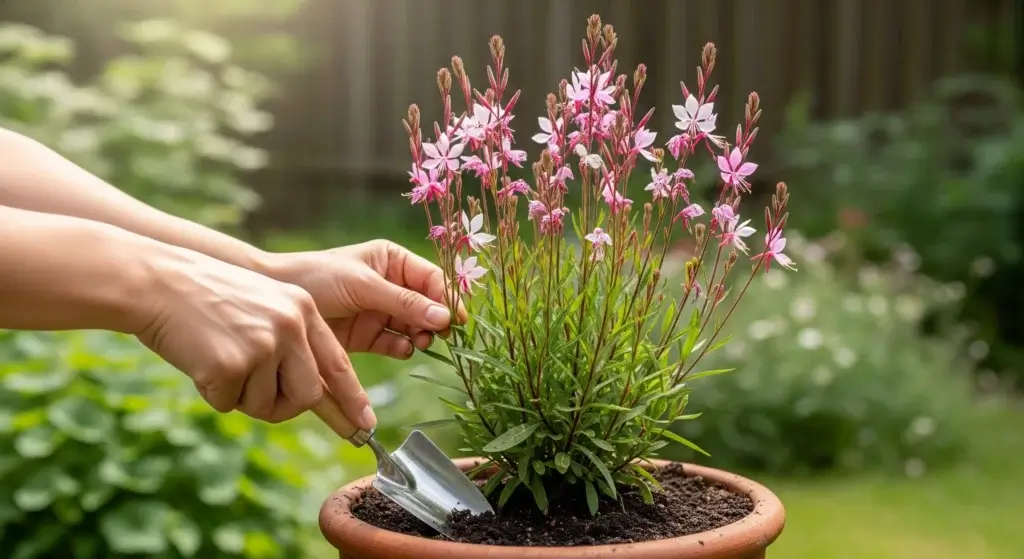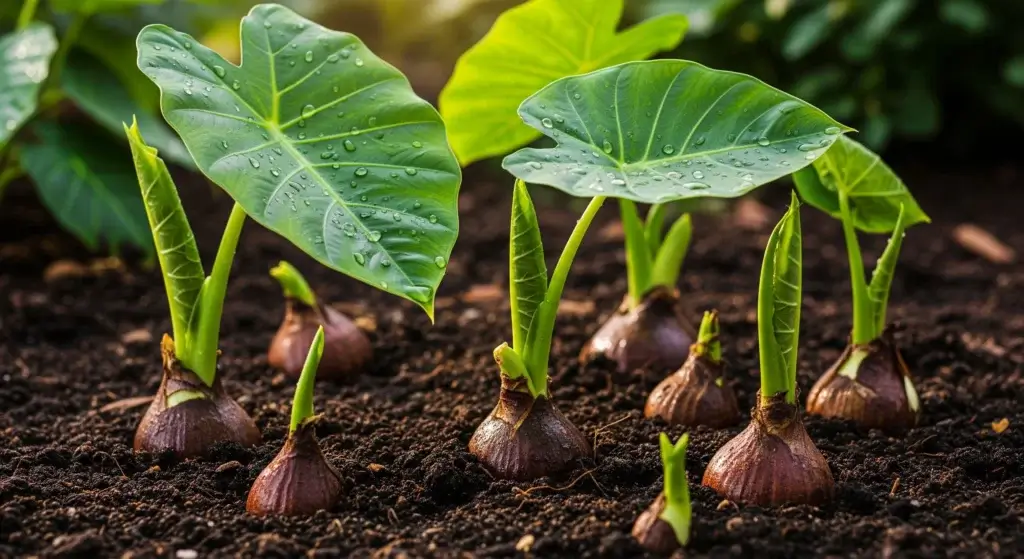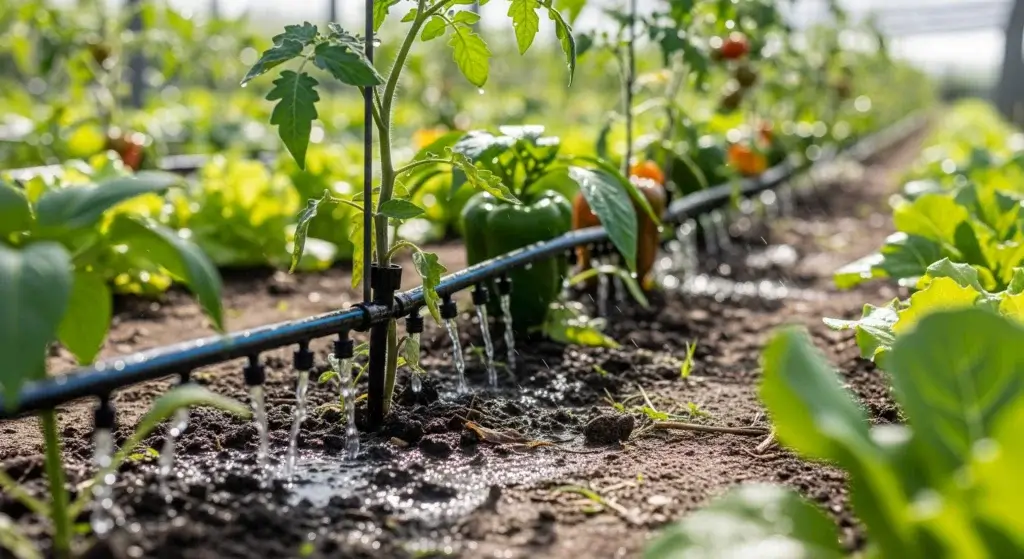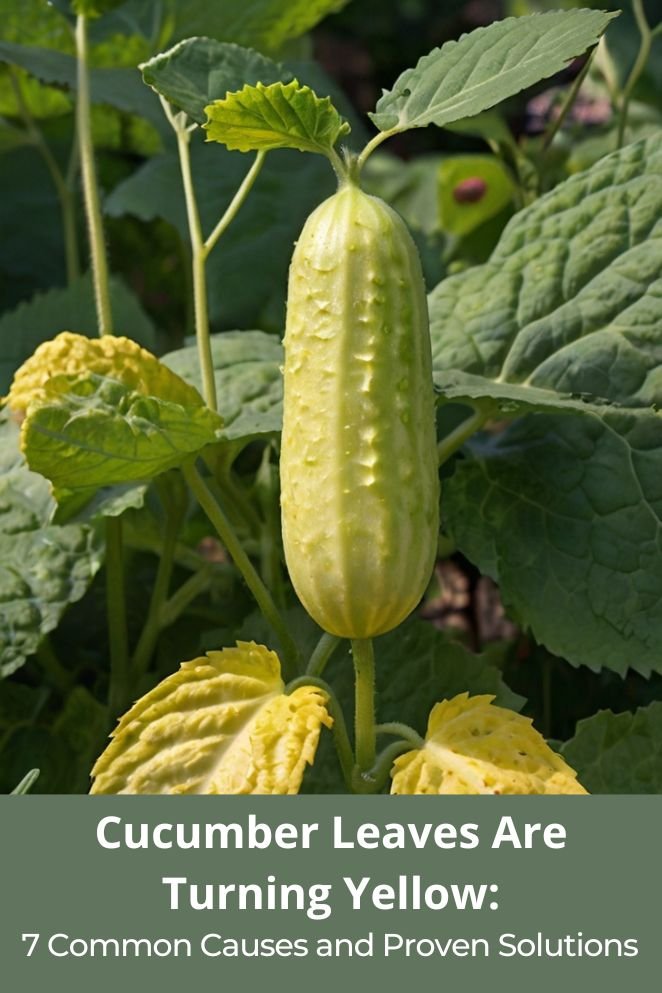
Yellow cucumber leaves? Total buzzkill.
But hey, you’re not the only one—this happens to tons of gardeners, even the seasoned pros.
The trick is catching the problem early and knowing what your plant’s trying to say.
Cucumbers are basically the water bottles of the veggie world (96% water!), so they’re picky about how they’re treated—too much water, not enough, weird weather, or bad soil, and boom: yellow leaves.
Think of it like your plant sending an SOS.
Find the root cause (pun intended), adjust your care like you’re tweaking your Spotify playlist, and you’ll get those green leaves—and your future cucumber snacks—back in business.
Understanding the Science Behind Yellowing Cucumber Leaves
Before jumping into fixes, let’s talk about what yellow leaves actually mean.
When your cucumber plant starts fading from green to yellow, it’s usually because it’s not making enough chlorophyll—that’s the stuff that helps it turn sunlight into energy.
This can happen for a bunch of reasons: not enough nutrients, too much or too little water, pests sucking the life out of it, or a disease taking hold.
Look at where the yellowing starts.
If it’s the bottom leaves first, it’s probably missing key nutrients.
If the whole plant suddenly changes color, you might be dealing with disease or serious stress.
Spotting the pattern helps you figure out what to fix fast.
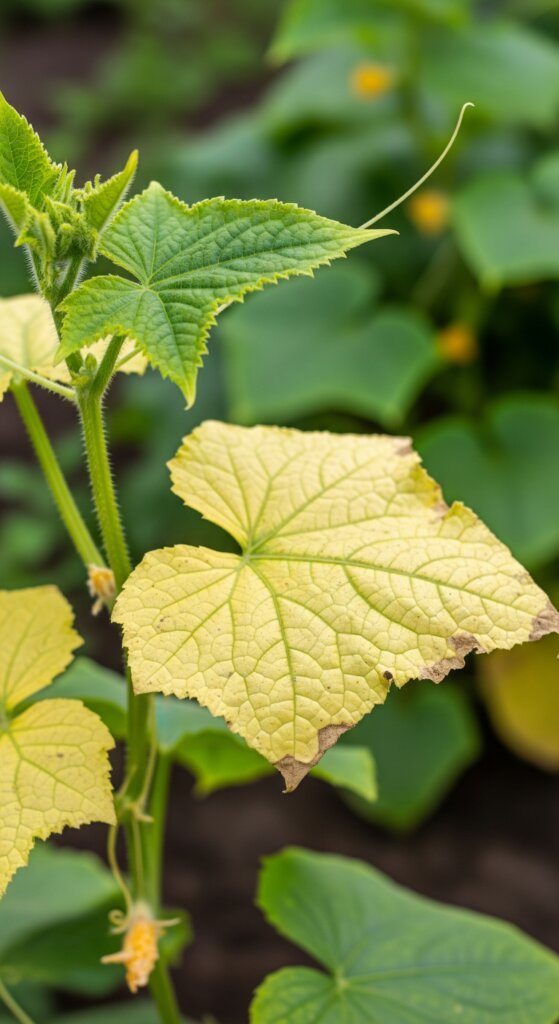
7 Common Causes and Proven Solutions
1. Improper watering
Overwatering
Let’s start with the most common problem—watering.
Too much or too little messes with your cucumbers fast.
Signs of overwatering include:
- Leaves feel soft or mushy
- Plant still wilts even though soil’s wet
- Fungi showing up near the stem
- Soil smells funky (like sour or musty)
Underwatering
Not watering enough? The plant goes into survival mode.
It sacrifices older leaves to save water. Signs of underwatering:
- Leaves turn yellow from the bottom up
- Leaves feel dry and crispy
Solution
To maintain proper soil moisture:
- Water deep 2–3 times a week—not a little every day
- Make sure your soil drains well (raised beds or loose soil help)
- Stick your finger 2 inches deep—if it feels dry, it’s time to water
- Use 2–3 inches of mulch to lock in moisture
- Drip irrigation? Even better. Keeps water steady and low stress
2. Nutrient Deficiencies
Cucumbers need a lot of food to grow well.
If they don’t get enough nutrients, their leaves start turning yellow—and fast.
This is one of the most common reasons gardeners run into leaf problems.
Nitrogen deficiency
If older leaves are yellowing first, your plant probably needs nitrogen.
It’s moving what little nitrogen it has to the new growth.
Potassium deficiency
When the edges of the leaves turn yellow or brown and look kind of crispy, that’s a potassium issue.
Potassium helps with fruiting, so it’s a big deal.
Magnesium deficiency
Yellowing between the veins (but the veins stay green)? That’s magnesium deficiency.
It gives the leaves a kind of striped look.
Solution
- Use a balanced fertilizer like 10-10-10 or 12-12-12 when planting
- Every 3–4 weeks, side-dress with compost or aged manure
- If you’re growing in containers, hit them with liquid fertilizer every two weeks
- Check your soil pH—aim for 6.0 to 7.0
- For magnesium issues, mix in a little Epsom salt (magnesium sulfate)
3. Pest infestations
Sometimes yellow cucumber leaves mean you’ve got uninvited guests.
These tiny pests feed on your plants or bring in diseases that mess with the leaves.
Aphids
These little soft bugs hang out on the undersides of leaves.
They suck out the plant’s juices, which makes the leaves curl, yellow, or twist. They also leave behind sticky gunk that can attract mold.
Spider mites
You probably won’t see them without a magnifying glass, but you will notice the fine webbing.
They suck on plant cells, which makes leaves look speckled before turning yellow or bronzed.
Cucumber beetles
Striped or spotted, these guys chew up the leaves and can also spread bacterial wilt, which can take out your whole plant fast.
How to deal with them
- Check your plants every week—early is easier
- Bring in good bugs like ladybugs and lacewings (they eat the bad ones)
- Spray with neem oil or insecticidal soap for soft-bodied pests
- Use row covers when your plants are just getting started
- Keep weeds under control—pests love to hide in them
- Rotate crops each year to keep bugs guessing
4. Fungal and bacterial diseases
Some yellowing isn’t from bugs or bad watering—it’s from disease.
And if you don’t catch it early, it can wipe out your cucumber plants fast.
Downy mildew
This shows up as pale yellow or white patches on top of older leaves.
Flip the leaf over and you’ll see fuzzy, grayish stuff underneath. It loves cool, damp weather.
Bacterial wilt
Cucumber beetles spread this one. The plant starts yellowing and wilting fast.
Sadly, once it hits, there’s no cure—you’ve got to focus on keeping it from happening in the first place.
Fusarium wilt
This one comes from the soil. Yellowing starts low and climbs.
Eventually, the plant just gives out.
Solution
- Pick disease-resistant cucumber varieties
- Use drip irrigation instead of spraying water on the leaves
- Space your plants out so air can move through
- Don’t touch or prune wet plants—it spreads disease fast
- Remove sick-looking leaves or plants ASAP
- Use copper-based fungicides early, not after it’s a mess
- Rotate crops every 3–4 years
- Make sure your soil drains well—soggy roots attract trouble
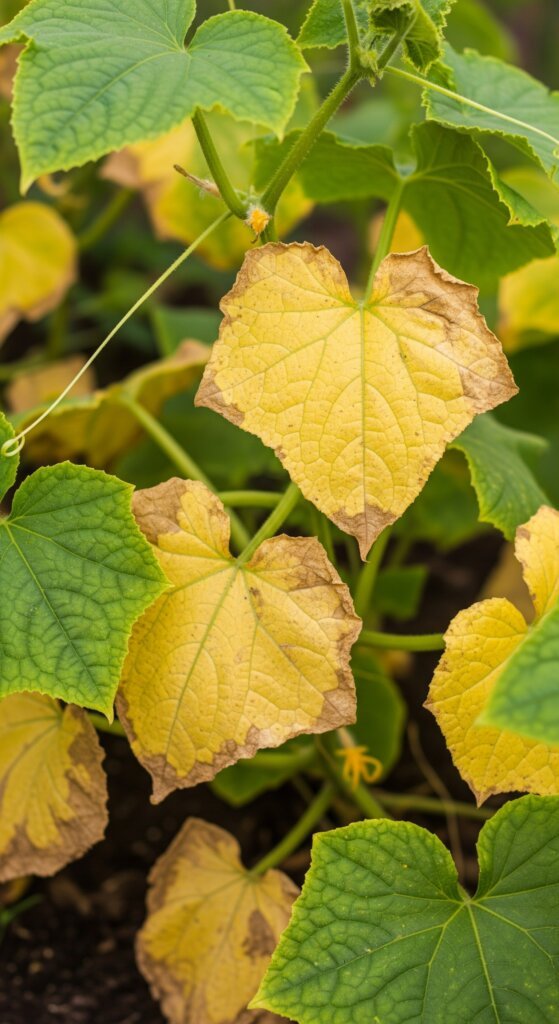
5. Environmental stress factors
Sometimes, your cucumber leaves turn yellow just because the environment’s out of whack.
It’s not you—it’s the weather, light, or even the soil.
Too hot or too cold
Cucumbers like it warm—but not too warm. Below 50°F (10°C) or above 95°F (35°C), they start to stress out.
That stress shows up as yellow leaves.
Too much or too little sun
They need full sun—about 6–8 hours a day—but when it’s blazing hot, too much sun can burn the leaves.
Not enough sun? They struggle to make energy, and yep, more yellowing.
Compacted soil
If your soil’s packed tight, roots can’t grow right and water can’t move through.
Plants get stressed, and the leaves turn yellow.
Solution
- Use shade cloth when temps go over 90°F (32°C)
- Space plants so air can flow between them
- Break up compacted soil with a broadfork or garden fork
- Mix in compost, peat moss, coconut coir, or vermiculite to keep soil loose
- Try raised beds if your ground soil stays soggy
- Add mulch to keep soil temps steady
6. Natural aging process
Sometimes yellow leaves just mean your cucumber plant’s getting older—and that’s totally normal.
As it starts cranking out fruit, it lets go of the older, lower leaves to focus energy on new growth and cucumbers.
How to tell if it’s normal
Normal aging yellowing:
- Only the oldest leaves at the bottom are yellow
- It’s happening slowly, not all at once
- The rest of the plant looks fine—no wilting or weird spots
- You’re in peak harvest mode
When it’s not normal
- Lots of leaves turning yellow at the same time
- Yellowing is moving fast
- Young leaves at the top are affected
- You also see wilting, curling, or spotting
7. Container growing challenges
Growing cucumbers in containers? It’s totally doable—but they’ve got their own set of problems that can cause yellow leaves if you’re not careful.
Nutrients run out fast
Pots don’t hold much soil, so nutrients get used up quicker.
You’ll need to feed them more often than cucumbers in the ground.
Drainage problems
If your container doesn’t drain well, the roots sit in soggy soil.
That leads to yellowing and stressed-out plants.
Root bound trouble
Small containers = cramped roots.
When cucumbers get root bound, they can’t take in enough water or nutrients—and yep, more yellowing.
Solution
- Use big containers—at least 20 gallons for vining types
- Make sure there are plenty of drainage holes
- Use good potting mix, not garden soil (it compacts too much)
- Fertilize more often—containers need the extra boost
- Check soil moisture daily when it’s hot
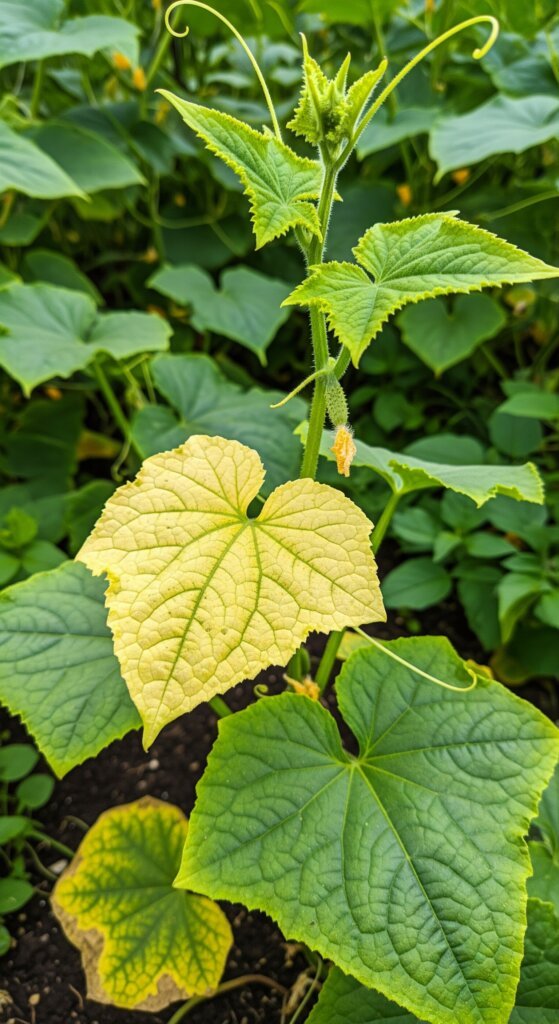
Prevention: The Best Medicine
The best way to deal with yellow cucumber leaves? Don’t let them happen in the first place.
A solid setup and good habits go a long way. Here’s how to stay ahead of the game:
Get your soil right
- Test the pH—cucumbers like it between 6.0 and 7.0
- Mix in 2–4 inches of compost before planting
- Make sure water drains well
- Add more organic matter every season
Pick smart, space right
- Go with disease-resistant varieties that match your climate
- Give them space—about 36–48 inches between plants
- Grow them vertically to boost airflow and save ground space
Stick to a simple routine
- Water consistently, don’t let the soil dry out too much or stay soaked
- Check on your plants every week for pests or signs of disease
- Fertilize based on what your soil actually needs (use a soil test)
- Add mulch to keep moisture in and weeds out
- Set things up right from the start, and you’ll have fewer problems—and way more cucumbers.
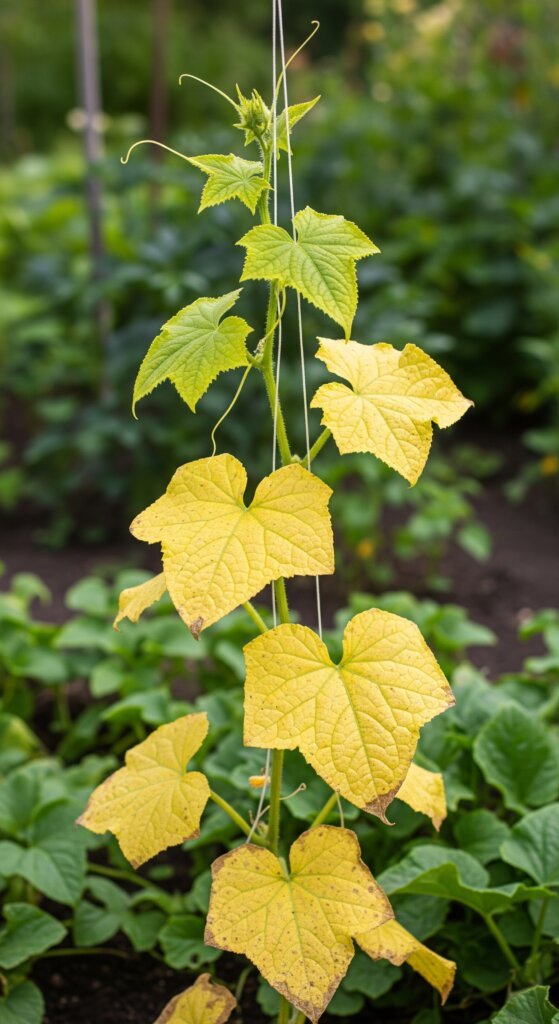
When to Seek Professional Help
Sometimes, no matter what you try, the yellowing just won’t stop.
That’s when it’s smart to get a second opinion. Don’t wait too long—ask for help if:
- The yellowing spreads fast and nothing you’ve tried is working
- You think it might be a disease but can’t tell which one
- Lots of plants in your garden are showing the same symptoms
- You need help figuring out your soil or what kind of fertilizer to use
Reach out to your local extension office or a garden pro. They’ve seen it all and can help you get things back on track.
Wrap-Up: Keep Your Cucumber Plants Happy and Green
Yellow leaves don’t mean your cucumber season’s over—it just means something needs fixing.
Whether it’s watering, bugs, diseases, or just aging leaves, the key is catching it early and knowing what to do.
Stick to the basics: prep your soil, pick the right varieties, space them out, and stay on a regular care routine.
Keep an eye on your plants, and jump on problems fast.
Don’t be afraid to ask for help if things get out of hand. With the right approach, you’ll have healthy, green vines and plenty of cucumbers to show for it.

